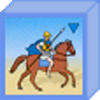Historical Background
During the Second, or Great, Peloponnesian War (431-404 BC) the Athenians recognized their inferiority to Sparta in land warfare, and chose to fight with proxy forces and at sea. Nevertheless, there were many small battles, and the clash at Olpae is representative. In 426, the Spartan general Eurylochus was operating in western Greece with a small force of Hoplites. He convinced the Ambraciots to invade Amphilokia, and their forces joined him at Olpae. In response, the Amphilokians called on their allies and the nearby Athenian fleet under Demosthenes. Demosthenes only had a small force, but was chosen to be the strategos, or commander, of the allied army. Eurylochus deployed with his Peloponnesians on the left and Ambraciots on the right. Demosthenes countered with his Messenians on the right, Arcanians in the center and Amphilokians on the left. Seeing that his army was badly outnumbered, Demosthenes extended his left wing with light troops and posted a picked force in hiding to ambush the Spartan right. When the lines clashed, Demosthenes sprung his ambush and routed the Peloponnesians, killing Eurylochus. Meanwhile, the Ambraciots also routed the Athenian left, but Demosthenes was able to keep his victorious wing in good order and attacked these troops, completing his victory. This victory recharged Demosthenes’ career, but gained little for Athens.
The stage is set. The battle lines are drawn and you are in command. Can you change history?

 |
 |
 |
 |
 |
 |
||||||||||||||
| 1 | 1 | 4 | 5 | 1 | 3 | ||||||||||||||
 |
 |
 |
 |
 |
 |
||||||||||||||
| 2 | 1 | 3 | 2 | 3 | 2 |
War Council
Athenian Army
(Use Greek light blue blocks)
• Leader: Demosthenes
• 6 Command Cards ![]()
![]()
![]()
![]()
![]()
![]()
• Move First ![]()
Spartan Army
(Use Spartan orange and
bronze Hoplite blocks)
• Leader: Eurylochus
• 5 Command Cards ![]()
![]()
![]()
![]()
![]()
Victory
6 Banners
Special Rules
• The Athenian ambush force may be deployed onto the battlefield when the Athenian player plays an Inspired Leadership Center or Right Command card in the section noted on the card. When playing a Leadership Any Section, the force may be deployed in either the Center or Right section (Athenian player’s choice). Place the units adjacent to or on a vacant forest hex. Place the leader with one of the units. These units may not move but may battle, and may Momentum Advance after a successful Close Combat and Bonus Close Combat if eligible.
• The Hoplite Infantry rule is in effect.
• Three Spartan units are special bronze five block MH units.
